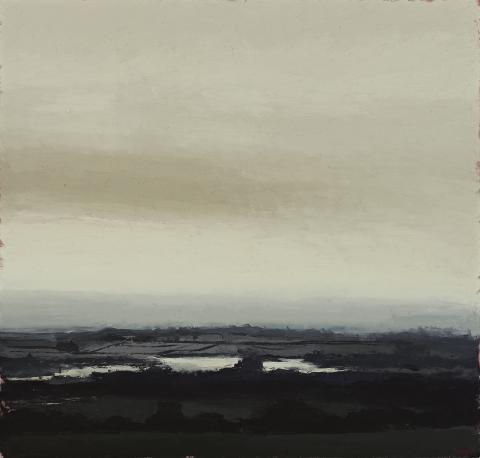SUMMER FLOOD I, 2004
PHILIP WOLFHAGEN
oil and beeswax on linen
200.0 x 210.0 cm
signed with initial, dated and inscribed lower right: W / JULY / 2004 / “Summer / flood I”
artist’s stamp lower right
signed, dated and inscribed verso: Philip Wolfhagen / “Summer flood I” 2004 / […]
Sherman Galleries, Sydney (stamped and label attached verso)
Gene and Brian Sherman collection, Sydney
Philip Wolfhagen’s characteristic swathes of waxy paint are instantly recognisable in the large-scale painting, Summer Flood I. This work was painted in 2004, the same year as some of the artist’s most abstracted works, a series titled Landscape Semaphore, was exhibited in The Inner Edge at Sherman Galleries. Summer Flood I, however, seems to switch between formal abstraction and semi-photographic realism, depending on the distance from which one views the painting, and the immersive effects of its expansive scale, small nicks and scrawled lines morph into forms both natural and manmade.
The struggle for dominance between the painting’s formal qualities and a recognisable scene echoes another dichotomy apparent in Wolfhagen’s work – that of the tension between man’s material culture and the quiet power of the natural landscape. The view presented here by Wolfhagen, a flooded plain after a summer storm, is indistinct. Without an obvious single focal point, the scene relies on suggested visual clues: a hazy grey afternoon light, a bright shimmering reflection on the surface of floodwaters, a blanket of fog blurring the low horizon. This is mimetic representation stripped back to bare essentials, muted and unassuming, but rich and detailed in its densely worked surface.
Wolfhagen’s practice is rooted in established processes, to which he adheres with rigour for five hours every morning.1 He has adopted a serial and repetitive approach to subject matter and style, creating a vast oeuvre from small changes in tone and composition applied to similar vistas of the land, sea and sky. Wolfhagen’s work is not created en plein air, as one would imagine. Instead the canvases are worked and reworked within the artist’s colonial studio, using photographs and occasional sketches for visual reference. Wolfhagen is an artist who draws attention to the sensory experience of inhabiting a portion of land and time. His artistic process, however, imposes distance between the artist and his physical subject – giving room for tweaks, reinventions and incursions into the artist’s imagination.
Philip Wolfhagen is currently recognised as one of Australia’s leading contemporary landscape painters, laureate of the Wynne Prize in 2007, and awarded the Centenary Medal for his contribution to the arts in 2001. Wolfhagen has worked steadily over the last twenty-five years, reviving a formerly unpopular genre of painting by systematically returning to the same views of Tasmania’s Midlands, his ancestral home.2 Wolfhagen conveys a deep emotional connection to the land and its history through nuances of colour and texture. In this respect, Wolfhagen follows in the footsteps of the great Romantic landscape painter, John Constable, an artist whom he admires,3 adhering to his maxim: ‘Still I should paint my own places best; painting is with me but another word for feeling’.4
1. McDonald J., ‘Philip Wolfhagen’, Sydney Morning Herald, 13 July 2013
2. Hansen, D. ‘O Earth, Return’, Art And Australia, vol. 42, Spring 2004, p. 92
3. Clark J., ‘Painting Memory’, Illumination: The Art of Philip Wolfhagen, Newcastle Art Gallery, Newcastle, 2013, p. 22
4. Letter to Rev. John Fisher, 23 October 1821, from John Constable's Correspondence VI: The Fishers, Suffolk Records Society, Ipswich, 1968, pp. 76 – 78
LUCIE REEVES-SMITH
